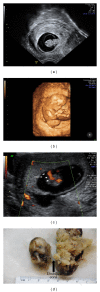Body stalk anomaly in a 9-week pregnancy
- PMID: 25105039
- PMCID: PMC4109598
- DOI: 10.1155/2014/357285
Body stalk anomaly in a 9-week pregnancy
Abstract
Body stalk anomaly is a rare and severe malformation syndrome in which the exact pathophysiology and trigger factors are still unknown. This is a case of a 30-year-old patient who underwent ultrasound at 9 weeks of gestation. It revealed an abnormal location of the inferior body of the embryo in the coelomic space. The findings suggested a short umbilical cord syndrome. In order to confirm the diagnosis, the patient was scheduled for a second ultrasonography at 11 weeks of gestation. The obtained images, confirmed the location of the inferior body in the coelomic space with no visible bladder, absence of the right leg, severe abdominal wall defect, consistent with an omphalocele, and a short 5 mm umbilical cord. These last ultrasonographic findings were consistent with body stalk anomaly. Because of severe malformation incompatible with life, the patient was offered termination of pregnancy. Pathologic examination confirmed the suspected pathology of body stalk anomaly.
Figures
References
-
- Daskalakis G, Sebire NJ, Jurkovic D, Snijders RJM, Nicolaides KH. Body stalk anomaly at 10–14 weeks of gestation. Ultrasound in Obstetrics and Gynecology. 1997;10(6):416–418. - PubMed
-
- Tsirka A, Korkontzelos I, Diamantopoulos P, Tsirkas P, Stefos T. Prenatal diagnosis of body stalk anomaly in the first trimester of pregnancy. Journal of Maternal-Fetal and Neonatal Medicine. 2007;20(2):183–184. - PubMed
-
- Takeuchi K. Body stalk anomaly: prenatal diagnosis. International Journal of Gynecology and Obstetrics. 1995;51(1):49–52. - PubMed
-
- Miller ME, Higginbottom M, Smith DW. Short umbilical cord: its origin and relevance. Pediatrics. 1981;67(5):618–621. - PubMed
-
- Mann L, Ferguson-Smith MA, Desai M, Gibson AA, Raine PA. Prenatal assessment of anterior abdominal wall defects and their prognosis. Prenatal Diagnosis. 1984;4(6):427–435. - PubMed
LinkOut - more resources
Full Text Sources
Other Literature Sources


